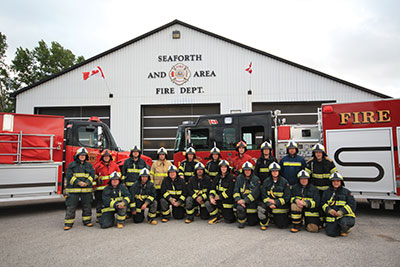
Equipment
Techsmart: Making headway
You’ve heard the saying the fire service is 200 years of tradition, unimpeded by progress?
September 9, 2013
By Olivia D’Orazio
You’ve heard the saying the fire service is 200 years of tradition, unimpeded by progress?
You’ve probably also been a cog in that wheel – taking off your SCBA during overhaul, when you know there are toxins in the air, or maybe laughing at those strange-looking, straight-out-of-Star-Wars, European-style helmets that have been popping up on fire grounds across North America.
 |
|
| Members of the Seaforth and Area Fire Department in Ontario opted to replace their traditional helmets with the European-style helmets after testing the helmets at a few calls. Photo courtesy of seaforth and area fire dept.
|
But the evidence is there to back the design’s efficacy, and several manufacturers have taken notice.
Rosenbauer’s Heros-xt helmet and Bullard’s Magma helmet feature similar design components, which, among other safety benefits, make the helmets more comfortable to wear. For starters, there is no eagle or beaver to get snagged on wires or other objects, and there is no brim to make mobility an issue.
The rounded helmets more evenly distribute weight on the wearer’s head, making for fewer neck problems. They also protect the wearer from side impacts. Bullard’s Magma helmet is available in two shapes – a half shell and a three-quarter shell – providing two levels of protection.
Kyle Innis, operations manager at ResQtech, which distributes the Rosenbauer helmet in Canada, says the first benefit of the helmet is its overall design.
“We’ve eliminated the brim. It extends straight down [and] provides a more ergonomic design,” he says.
“If you compare it to a traditional helmet, it’s low profile. There’s nothing protruding from it, like an eagle or a brim, so there are fewer snag points . . .”
The helmet also features a three-point chin strap, much like those found on motorcycle helmets. This provides better support and prevents the helmet from tipping or tilting as the user wears it.
The light is attached at the front of the helmet so that it shines where a user looks. Also, the light lies almost flat, ensuring that it also doesn’t get caught on anything.
The adjustment knob, meanwhile, is on the outside of the helmet, so that users can tighten or loosen the helmet with a gloved hand. Conversely, the face shield and goggles are integrated within the helmet. When not in use, the shield is fitted inside the helmet, where it remains protected.
The Bullard helmet has similar features, such as a multi-point strap and a face shield that slides inside the helmet.
Huron East Fire Department’s District Chief Tom Phillips, whose Seaforth station has been using the Heros-xt helmet for about two years, says he finds it easier to move around with this style of helmet, especially during extrication operations.
“[During] extrication, you can hit things and get the helmet knocked off,” he says. “With this helmet, it’s easier to manoeuvre if you have to get inside a vehicle.”
The greatest challenge with these helmets is the stigma attached to them. As Phillips says, the traditional helmet is the firefighter’s helmet. But he urges any fire department that is considering making a switch to let the firefighters decide.
“I brought four [helmets] in and [the firefighters] had a chance to use them and wear them,” Phillips explains.
“When I brought them in, I showed them why I was bringing them in. I showed them the features: the adjusting knob, the face shield and goggles, the ear protection, the light.
“I haven’t heard one firefighter say anything about the helmet that they don’t like.”
It’s not the helmet that firefighters are used to, but Innis says that, once crews understand the reasons behind the various style changes, they tend to come around.
“We’re not trying to change the history of fire fighting,” Innis says. “We’re trying to keep the tradition of everybody coming home.”
For more on the Rosenbauer Heros-xt helmet, visit www.resqtech.com, and for information on the Bullard Magma helmet, visit www.bullard.com .
Print this page